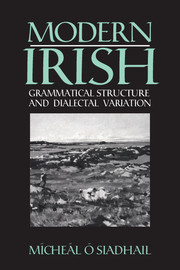Summary
Phonetic shape
General discussion
The inflection of the verb is affected by the use of various morphological and syntactic devices:
(a) Broadening of a root final consonant, e.g. bualadh ‘hitting’ beside buail ‘hit!’, siúl ‘walking’, siúil ‘walk!’;
(b) Addition of an ending to signify person, number etc., e.g. cuirim ‘I put’, from cuir ‘put!’;
(c) Placing before the verb an element which carries grammatical information other than person, number etc., e.g. (do) chuir (M) ‘put’ (past);
(d) Use of personal pronouns which are also found outside the verbal system to denote person, number etc., e.g. cuireann muid (C, D) ‘we put’;
(e) Use of periphrasis where a verbal noun is unmarked for person, number and tense, which are then attached to an auxiliary verb, e.g. tá sé ag bualadh ‘he is hitting’.
There is no absolute distinction between morphology and syntax. Those listed as (a) and (b) above are largely morphological while (e) is generally regarded as syntactical. This section deals with the morphological or inflectional side of matters; the use of periphrasis by which certain features of aspect and passivity are expressed by auxiliary verbs will be discussed in 11.3.
- Type
- Chapter
- Information
- Modern IrishGrammatical Structure and Dialectal Variation, pp. 169 - 202Publisher: Cambridge University PressPrint publication year: 1989



